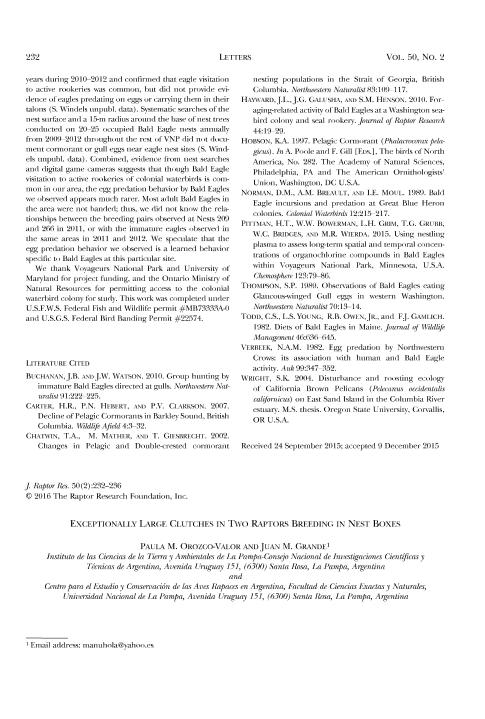Mostrar el registro sencillo del ítem
dc.contributor.author
Orozco Valor, Paula Maiten

dc.contributor.author
Grande, Juan Manuel

dc.date.available
2018-05-04T18:52:40Z
dc.date.issued
2016-06
dc.identifier.citation
Orozco Valor, Paula Maiten; Grande, Juan Manuel; Exceptionally Large Clutches in Two Raptors Breeding in Nest Boxes; Raptor Research Foundation; Journal of Raptor Research; 50; 2; 6-2016; 232-236
dc.identifier.issn
0892-1016
dc.identifier.uri
http://hdl.handle.net/11336/44203
dc.description.abstract
Nest site availability may limit secondary cavity-nesters because they are unable to create their own cavities and thus are forced to use existing cavities. Nest boxes can help to overcome this limitation but they can affect clutch size. In South America, the Ferruginous Pygmy-Owl (Glaucidium brasilianum) clutch size usually ranges from two to five eggs. The American Kestrels (Falco sparverius) clutch size usually ranges from four to six eggs. In South America all recorded clutch sizes in the late species did not exceed five eggs. Here we present records of same season exceptionally large clutches for both species breeding in nest boxes put up for American kestrels in central Argentina. Every year since 2011-2012 a maximum from 24 to 104 nest boxes have been monitored. In the 2014-2015 breeding season one of the boxes was occupied by Ferruginous Pygmy-owls. This pair laid an exceptional clutch of seven eggs (to our knowledge the largest clutch ever recorded for the species in South America).Six nestlings fledged successfully. In the same season, unusually large clutches were recorded for American Kestrels too, with six clutches of six eggs, three clutches of seven eggs and one clutch of eight eggs (as far as we know, the largest ever recorded globally for the species). However, hatching never exceeded six individuals in any of the exceptional clutches. Extremely large clutches reported here are probably the result of an exceptionally good year in food resources for these two species. The unusual clutch sizes may have been also related to breeding in spacious nest boxes and in the case of the American Kestrels could also be favored by the larger size of the South American subspecies.
dc.format
application/pdf
dc.language.iso
eng
dc.publisher
Raptor Research Foundation

dc.rights
info:eu-repo/semantics/openAccess
dc.rights.uri
https://creativecommons.org/licenses/by-nc-sa/2.5/ar/
dc.subject
Clutch Size
dc.subject
Falco Sparverius
dc.subject
Glaucidium Brasilianum
dc.subject
Nest Box.
dc.subject.classification
Otras Ciencias Biológicas

dc.subject.classification
Ciencias Biológicas

dc.subject.classification
CIENCIAS NATURALES Y EXACTAS

dc.title
Exceptionally Large Clutches in Two Raptors Breeding in Nest Boxes
dc.type
info:eu-repo/semantics/article
dc.type
info:ar-repo/semantics/artículo
dc.type
info:eu-repo/semantics/publishedVersion
dc.date.updated
2018-05-04T14:59:39Z
dc.journal.volume
50
dc.journal.number
2
dc.journal.pagination
232-236
dc.journal.pais
Estados Unidos

dc.journal.ciudad
Lawrence, Kansas
dc.description.fil
Fil: Orozco Valor, Paula Maiten. Consejo Nacional de Investigaciones Científicas y Técnicas. Instituto de Ciencias de la Tierra y Ambientales de La Pampa. Universidad Nacional de La Pampa. Facultad de Ciencias Exactas y Naturales. Instituto de Ciencias de la Tierra y Ambientales de La Pampa; Argentina
dc.description.fil
Fil: Grande, Juan Manuel. Consejo Nacional de Investigaciones Científicas y Técnicas; Argentina. Universidad Nacional de La Pampa. Facultad de Ciencia Exactas y Naturales. Departamento de Recursos Naturales. Centro para el Estudio y Conservación de Aves Rapaces; Argentina
dc.journal.title
Journal of Raptor Research

dc.relation.alternativeid
info:eu-repo/semantics/altIdentifier/doi/http://dx.doi.org/10.3356/0892-1016-50.2.232
dc.relation.alternativeid
info:eu-repo/semantics/altIdentifier/url/http://www.bioone.org/doi/10.3356/0892-1016-50.2.232
Archivos asociados
